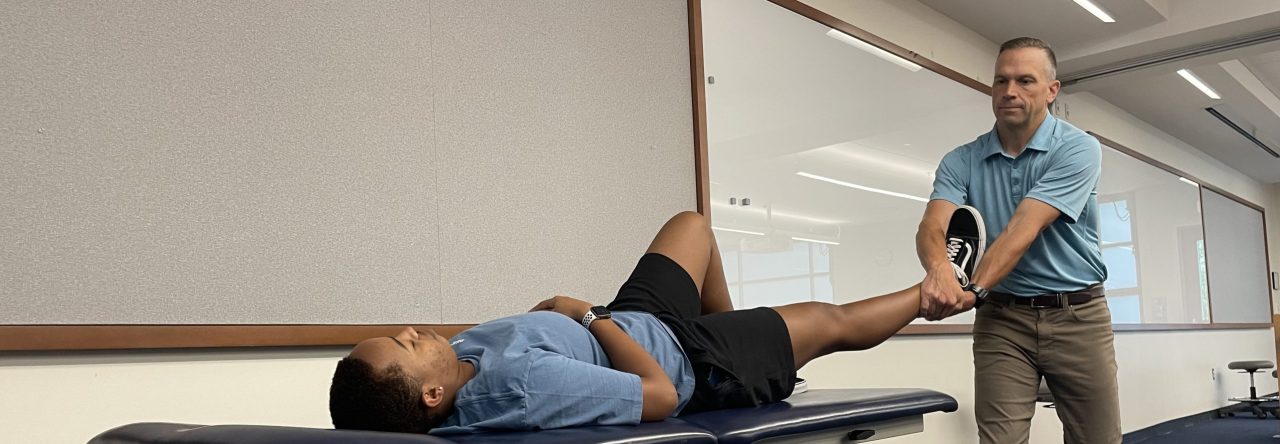Author Names
Selhorst, M., & Selhorst, B.
Reviewer Name
Michelle Su
Reviewer Affiliation(s)
Duke University Doctor of Physical Therapy Division
Paper Abstract
Objectives: Low back pain (LBP) is a common condition in adolescents. Although much has been written about the efficacy of lumbar manipulation for adults with LBP, little is known about its effectiveness in adolescents. This study had two primary aims: (1) to assess the efficacy of adding lumbar manipulation to an exercise program in adolescents with acute (>90 days) LBP and (2) to report and assess any adverse reactions associated with lumbar manipulation noted in this study. Methods: Patients were randomly assigned to receive lumbar manipulation or sham manipulation. All patients performed 4 weeks of physical therapy exercise. Pain, patient-specific functional scale (PSFS), and global rating of change (GROC) scores were measured at evaluation, 1 week, 4 weeks, and 6 months. Relative risk was calculated for adverse reactions noted. Results: We recruited 35 consecutive patients with acute LBP. One patient was excluded after being diagnosed with a spondylolysis, 34 patients remained for analysis. Both groups experienced significant improvement over time in all measures. There were no differences between groups for pain, PSFS, or GROC scores. No increased risk of adverse reaction from lumbar manipulation was noted. Discussion: The addition of lumbar manipulation to exercise did not benefit adolescents with acute LBP. There was not an increased risk of an adverse reaction noted in this study from lumbar manipulation performed on adolescents. Further research needs to be done to identify factors that predict positive outcomes following lumbar manipulation in adolescents.
NIH Risk of Bias Tool
Quality Assessment of Controlled Intervention Studies
- Was the study described as randomized, a randomized trial, a randomized clinical trial, or an RCT?
- Yes
- Was the method of randomization adequate (i.e., use of randomly generated assignment)?
- Yes
- Was the treatment allocation concealed (so that assignments could not be predicted)?
- Yes
- Were study participants and providers blinded to treatment group assignment?
- Yes
- Were the people assessing the outcomes blinded to the participants’ group assignments?
- Cannot Determine, Not Reported, or Not Applicable
- Were the groups similar at baseline on important characteristics that could affect outcomes (e.g., demographics, risk factors, co-morbid conditions)?
- Yes
- Was the overall drop-out rate from the study at endpoint 20% or lower of the number allocated to treatment?
- No
- Was the differential drop-out rate (between treatment groups) at endpoint 15 percentage points or lower?
- Cannot Determine, Not Reported, or Not Applicable
- Was there high adherence to the intervention protocols for each treatment group?
- Yes
- Were other interventions avoided or similar in the groups (e.g., similar background treatments)?
- Yes
- Were outcomes assessed using valid and reliable measures, implemented consistently across all study participants?
- Yes
- Did the authors report that the sample size was sufficiently large to be able to detect a difference in the main outcome between groups with at least 80% power?
- Yes
- Were outcomes reported or subgroups analyzed prespecified (i.e., identified before analyses were conducted)?
- Yes
- Were all randomized participants analyzed in the group to which they were originally assigned, i.e., did they use an intention-to-treat analysis?
- Yes
Key Finding #1
Lumbar manipulation adds no benefit to exercise in pain-rating or function in adolescents aged 13-17 with acute mechanical low back pain at 1 week, 4 week, and 6 month follow-ups.
Key Finding #2
At 6-month follow-up, 65% of patients in both groups still had LBP or had a recurrence of symptoms.
Key Finding #3
13 of 31 patients sought additional treatment for LBP symptoms after the 4 weeks of exercise ended.
Key Finding #4
Outcomes measures of PSFS, pain, and GROC are not established in the adolescent population.
Please provide your summary of the paper
This article studied the effects of lumbar manipulation with exercise, compared to sham manipulation with exercise in adolescents with mechanical LBP with duration of symptoms <90 days. The study used patient-specific functional scale (PSFS), numeric pain-rating scale (NPRS), and GROC to determine outcomes. The physical therapist performing the manipulation was different than exercise therapist and both the exercise therapists and patients were blinded The results showed that the addition of lumbar manipulation to exercise did not benefit adolescence with acute LBP, though there is no increased risk of an adverse reaction from lumbar manipulation. A limitation to this study is that the MCIDs of NPRS, PSFS and GROC have not been established in the adolescent population. Additionally, only one type of manual therapy was prescribed.
Please provide your clinical interpretation of this paper. Include how this study may impact clinical practice and how the results can be implemented.
Seeing that both groups had unresolved LBP despite exercise interventions, future research should focus on reducing acute and long-term LBP in adolescents. Furthermore, the author states that they have experienced a population of adolescents that benefit from lumbar manipulation for the duration of the treatment session, suggesting that we should not fully negate the option of lumbar manipulation for pain reduction.
